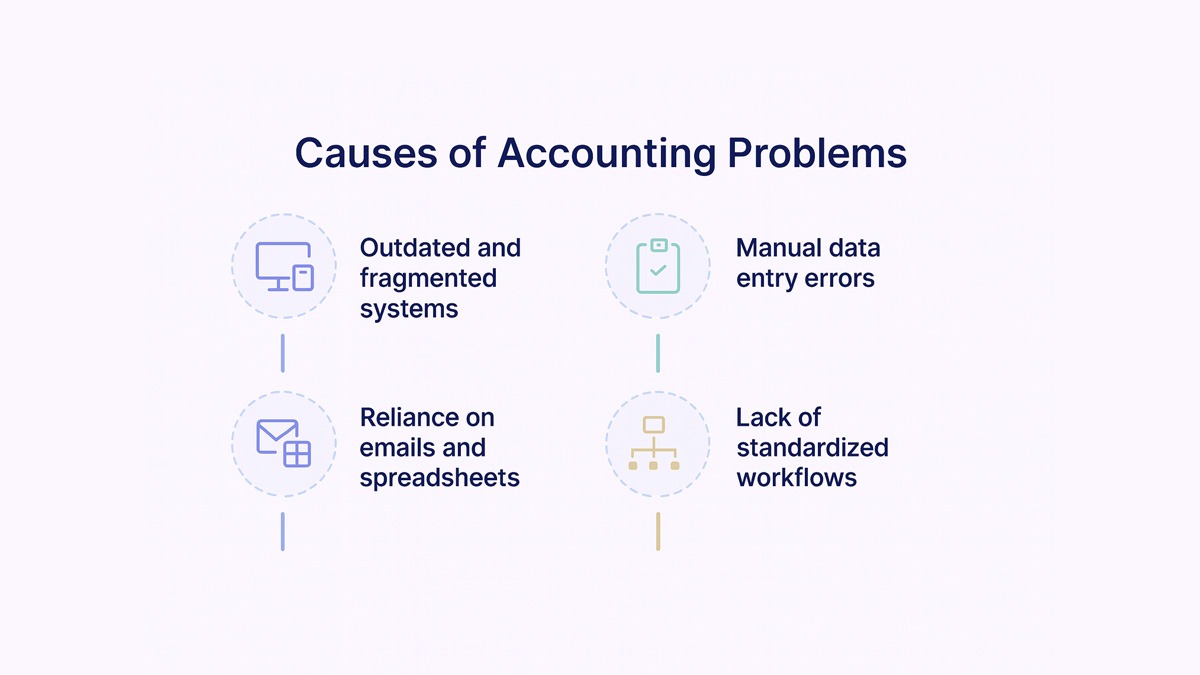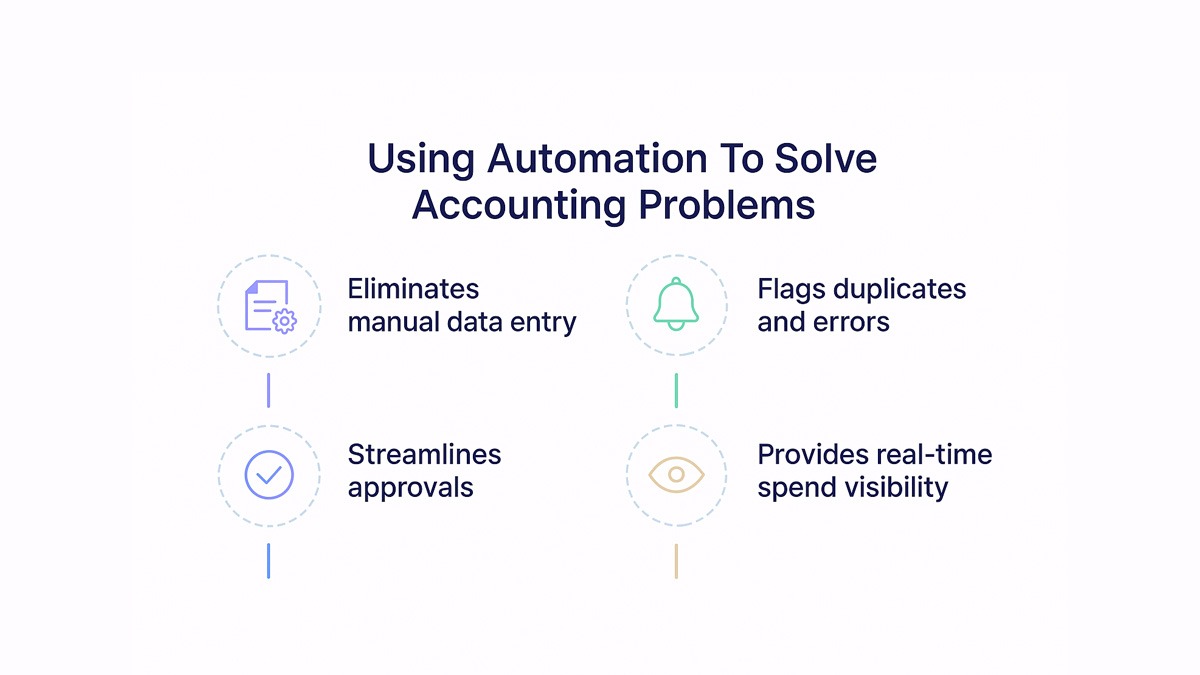

11 Common Accounting Problems (And How to Finally Fix Them in 2025)

11 Common Accounting Problems (And How to Finally Fix Them in 2025)
Explore 11 accounting problems and how automation helps modern finance teams improve accuracy, compliance, and control.


Imagine running a business where a single wrong number in a spreadsheet delays payroll or causes a duplicate vendor payment. It sounds small - until it isn’t. Using modern payroll apps minimizes delays and automates salary calculations. As businesses scale and transactions multiply, even minor accounting issues can snowball into major financial headaches. In 2025, with increasing pressure for real-time accuracy and regulatory compliance, staying on top of accounting problems isn’t optional - it’s essential.
What this blog covers:
- What are accounting problems?
- What causes accounting problems?
- How do businesses solve accounting problems?
- 11 common accounting problems
- Using automation to solve accounting problems
- How Spendflo helps with accounting accuracy and AP control
- Frequently asked questions on accounting problems
What are Accounting Problems?
Accounting problems are issues that disrupt the accuracy, timeliness, or compliance of financial records. These may include data entry errors, missed payments, duplicate invoices, or incomplete audit trails, all of which can impact business performance and regulatory obligations.
What Causes Accounting Problems?
Most accounting problems stem from outdated processes and fragmented systems. Manual data entry, disconnected tools, and inconsistent workflows create space for errors - whether it’s a duplicated invoice or a missed payment deadline. Teams often rely on spreadsheets or emails for approvals, leading to delays and miscommunication. A lack of standardized procedures across departments only makes things worse. When financial operations aren’t aligned or automated, small mistakes can easily slip through the cracks and escalate into serious reporting or compliance issues.

How Do Businesses Solve Accounting Problems?
Businesses solve accounting problems by replacing manual tasks with automated systems that centralize data and streamline approvals. Maintaining a well-structured chart of accounts ensures every transaction aligns with financial reporting standards. Digital tools help flag errors early, enforce workflows, and ensure consistency across procurement and finance. Digital accounting solutions streamline complex processes and maintain financial accuracy. With real-time tracking, internal controls, and regular audits, companies shift from reactive fixes to proactive prevention - building a system that reduces errors before they occur. Strengthening internal processes and controls ensures sustainable financial governance.
11 Common Accounting Problems
Even the most experienced finance teams run into accounting snags. But these issues don’t usually start with big blunders - they creep in through small inefficiencies, overlooked details, or manual errors. Here’s a breakdown of the most common accounting problems businesses face, along with proactive steps to prevent them before they escalate.
Inaccurate Data Entry
Manual entry of invoices, vendor details, or payment information is still surprisingly common - and notoriously error-prone. Modern bookkeeping tools make it easier to record and categorize transactions accurately. A single mistyped number can throw off your books, delay payments, or trigger compliance issues. Multiply that across hundreds of transactions, and you’ve got a real mess to untangle. Receipt matching ensures every transaction is supported by verified proof of purchase. Integrating 3rd party tools enhances visibility and reduces manual intervention.
Precautions to take:
- Use automated data capture tools (OCR, invoice scanning software)
- Validate entries with two-step checks or approval workflows
- Limit data entry access to trained users only
- Integrate accounting software with procurement tools to reduce re-keying
Delayed Reconciliations
When account reconciliations are pushed to month-end or quarter-end, errors have more time to pile up. Delays make it harder to trace mistakes, leading to drawn-out investigations and missed close deadlines. Automated reconciliation helps detect mismatches instantly and keeps ledgers accurate. Real-time credit card feeds simplify tracking and minimize manual data entry. Regular bank reconciliations help detect errors and maintain up-to-date balances.
Precautions to take:
- Reconcile accounts weekly, not just monthly
- Use reconciliation automation software
- Assign dedicated owners to reconciliation tasks
- Set calendar reminders and escalation workflows for overdue reconciliations
Unclear Audit Trails
Without a clean trail of approvals, changes, and actions, audits become painful. Untracked changes in spreadsheets or missing documentation can raise red flags - even when nothing is actually wrong. These gaps often increase audit risks and compliance challenges. Strong encryption protocols protect sensitive audit data from unauthorized access. Operating in a cloud-based environment improves accessibility and keeps financial data secure across teams.
Precautions to take:
- Centralize documentation in a cloud-based platform
- Implement role-based access and version history tracking
- Ensure every transaction has a visible approval trail
- Archive communications and supporting files with each transaction
Duplicate Payments
Paying the same invoice twice might sound unlikely - but it happens more often than you’d think. Similar vendor names, vague invoice numbers, or overlapping workflows are often to blame. Advanced duplicate detection systems help prevent overpayments and catch recurring invoice errors. Advanced duplicate detection systems help prevent overpayments and catch recurring invoice errors.
Precautions to take:
- Use AP automation software with duplicate detection
- Enforce unique invoice number validation
- Restrict the ability to edit or re-upload approved invoices
- Set up vendor master data management controls
Missed Invoices or Payments
Lost invoices, forgotten due dates, and last-minute approvals all contribute to late payments. Not only does this affect vendor relationships, it can also mean missed discounts or penalties for delays.
Precautions to take:
- Automate invoice intake and reminders
- Create a centralized invoice dashboard
- Integrate approval workflows into communication tools like Slack or email
- Monitor invoice aging reports weekly
Poor Spend Visibility
Without a clear view into what’s being spent, by whom, and why, accounting teams operate in the dark. This makes budget planning, forecasting, and cost control nearly impossible.
Precautions to take:
- Consolidate all spend data into one dashboard
- Tag transactions with cost centers and project codes
- Run real-time reports to monitor budget vs. actuals
- Conduct monthly spend reviews with department heads
Unapproved Purchases
When employees bypass procurement or accounting to make purchases directly, it disrupts budget control and opens the door to fraud or shadow IT. These rogue purchases often surface too late.
Precautions to take:
- Require pre-approval for all purchases over a set threshold
- Use intake forms with automated routing for approvals
- Communicate procurement policies clearly and often
- Set user-based permissions on who can raise purchase requests
Vendor Mismatches
Payment errors can occur when vendor details in your accounting system don’t match what’s on the invoice - especially if there are multiple entities or addresses involved.
Precautions to take:
- Keep vendor master data up to date and verified
- Use a vendor onboarding process with validation steps
- Flag mismatches automatically using smart invoice tools
- Limit who can edit vendor records
Manual Errors in Reporting
Relying on spreadsheets for reporting can lead to formula errors, outdated data, or inconsistencies. One wrong cell can distort the entire financial picture.
Precautions to take:
- Automate reporting with integrated finance platforms
- Use templates with locked formulas and validated fields
- Double-check reports before sharing externally
- Set up peer review processes for sensitive reports
Non-Compliance With Tax Rules
As tax regulations evolve, it’s easy to fall behind. Incorrect tax codes, missed filings, or lack of audit documentation can result in penalties and reputational risk. A reliable backup system ensures accounting data can be quickly restored after errors or system failures.
Precautions to take:
- Keep tax compliance software updated
- Assign a compliance officer or third-party advisor
- Automate tax calculations at the transaction level
- Maintain digital audit trails for all taxable transactions
Lack of Real-Time Insights
Delayed reporting means decisions are often made with outdated information. That gap can affect cash flow forecasting, vendor negotiations, or even board reporting.
Precautions to take:
- Choose accounting tools that update in real time
- Connect spend and procurement systems for full visibility
- Use dashboards for key metrics like burn rate and cash flow
- Set up alerts for anomalies or threshold breaches
Using Automation To Solve Accounting Problems
Automation is one of the most effective ways to eliminate recurring accounting issues. It helps finance teams reduce manual work, minimize errors, and speed up approvals - without sacrificing control. By automating key steps across the procure-to-pay cycle, businesses can gain real-time visibility, prevent duplicate payments, and stay audit-ready at all times. Adopting digital solutions transforms accounting operations into efficient, transparent systems.

Here’s how automation makes a difference:
- Eliminates manual data entry through OCR and invoice scanning tools
- Flags duplicates and errors before payments are processed
- Streamlines approvals with pre-set workflows and Slack/email integrations
- Provides real-time spend visibility through centralized dashboards
How Spendflo Helps With Accounting Accuracy and AP Control
Spendflo brings clarity and control to your accounts payable process by centralizing vendor data, automating approvals, and eliminating manual errors. With real-time spend visibility, duplicate detection, and audit-ready workflows, finance teams can move faster while staying compliant and accurate - every step of the way.
Frequently Asked Questions on Accounting Problems
What are the most common accounting problems in accounts payable?
The most common issues include duplicate payments, late or missed invoices, incorrect data entry, and lack of audit trails. These problems often stem from manual processes and poor visibility across departments.
How can automation reduce accounting errors?
Automation removes the need for manual data entry, flags duplicates, and ensures approvals follow a clear workflow. It also provides real-time tracking and alerts, reducing the chances of human error or oversight.
What causes duplicate or missed payments in accounting?
Duplicate or missed payments usually result from poor invoice tracking, multiple systems not syncing properly, or lack of oversight. Without automation, it’s easy for the same invoice to be paid twice - or forgotten entirely.
How do businesses improve spend visibility in accounting?
By consolidating spend data into one platform, tagging expenses by category or department, and using real-time dashboards, businesses can get a clear picture of where their money is going and make informed financial decisions.
How do accounting teams maintain data security in a cloud-based environment?
In a hybrid workplace model, finance teams rely heavily on digital systems. Ensuring strong data security, using encryption protocols, and maintaining a robust backup system are essential. Cloud-based accounting platforms add another layer of safety, allowing teams to protect sensitive data while maintaining remote accessibility and compliance.
What are the best accounting methodologies for modern businesses?
Modern finance teams follow adaptive accounting methodologies that align with automation and cloud technology. Whether managing payroll, reconciliations, or audits, digital tools and data-driven insights help improve accuracy, transparency, and collaboration - especially in a cloud-based or hybrid work setting.










.png)




.png)










.avif)


